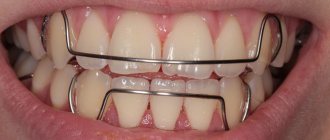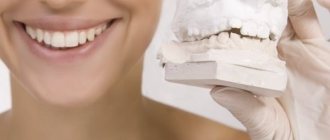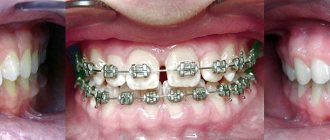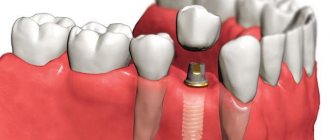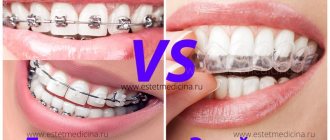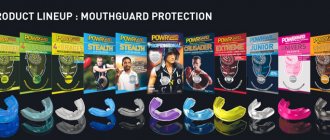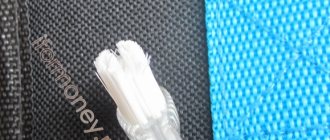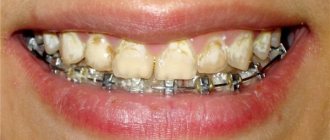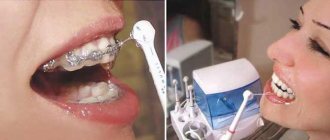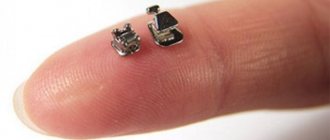Why did the retainer come off and how to put it back in place?
To straighten your teeth and give your smile a perfect look, braces are installed.
They need to be worn for a long time, sometimes several years. The final stage of this long and complex procedure is the installation of retainers, the main task of which is to consolidate the result obtained after wearing braces.
This recovery period is very important for the overall result of therapy, and if the retainer has come off, you should not put off an unplanned visit to the orthodontist.
Price
The final stage of teeth and bite alignment is also expensive for the patient. The price is determined based on the type of retention device, the duration of the rehabilitation period, additional services (consultations, professional cleaning, dental treatment, installation). The prices indicated are current as of January 2020.
On average, a retainer costs 6–8 thousand rubles. In clinics in the capital it will cost 19-25 thousand rubles. To this cost they usually add 800–2000 rubles for installation and 1–3 thousand rubles for professional teeth cleaning after removing braces.
Many clinics offer turnkey bite correction services. In this case, the cost of treatment is immediately agreed upon, which includes the installation of braces, then structures to consolidate the achieved result, and related procedures.
Benefits of permanent retainers
Wire structures, which are installed for constant wearing without the possibility of removal, are most popular among people. This is due to the presence of certain advantages that make this model stand out from the rest.
- Miniature sizes.
- This system does not cause discomfort when worn.
- Aesthetics. The retainer is installed on the lingual side of the teeth, so it remains invisible to others.
As for systems that can be removed, they are not effective enough due to the fact that people often forget to put them on before going to bed or after oral hygiene procedures. Plus, the metal wire is located on the front side of the teeth, which means it is visible to others.
Reasons for retainer peeling off
There are several factors that can cause a non-removable wire retainer to peel off or break.
- Contamination (pollution).
- Installing the retainer in the wrong place.
- Low level of professionalism of the orthodontist in the matter of filling.
- Unsatisfactory orthodontic treatment.
In most cases, the retainer comes off due to the negligence of the attending physician, but often the patient himself is to blame for the breakdown of the structure:
- Neglecting recommendations for following a diet and avoiding solid foods.
- Using dental floss to clean teeth with retainers.
- Lack of hygienic procedures for oral care.
Pollution
Most often, the retainer comes off due to a broken seal, which in turn becomes faulty due to contamination.
Before installing a retainer, the doctor is required to thoroughly treat the surface of the teeth, clearing them of saliva, blood and other liquids present in the oral cavity.
If the filling is installed on a poorly prepared tooth surface, then early failure cannot be avoided, which will lead to the retainer coming off.
Installing the system in the wrong location
Some specialists prefer to install removable retainers on the teeth of the upper jaw, since non-removable ones will quickly fail in this case. However, this is not the main mistake. Under no circumstances should the system be installed in a place where there is contact with antagonist teeth. Due to an incorrect bite, the retainer will be under constant stress, which will lead to it breaking or coming off.
Unprofessionalism of the doctor in matters of filling
Due to the fact that orthodontists very rarely install fillings, retainers often come off precisely because the filling was installed incorrectly or poorly, which led to its rapid destruction.
Poor results of orthodontic treatment
The retainer is installed after the braces are removed.
It is understood that in this case the bite has already been corrected and there are no deviations from the norm.
But there are cases when treatment turns out to be ineffective or illiterate, which leads to partial elimination of orthodontic problems.
If your teeth are not aligned properly, chewing will put excessive stress on your retainer, causing it to break or come loose.
Features of care
Oral hygiene while wearing fixed retainers is much simpler than caring for a brace system. You don’t have to have a bunch of cleaning equipment; you just need to learn a number of simple rules:
- teeth with a plate installed can be cleaned with a regular toothbrush and toothpaste; you just need to make careful movements so as not to damage the integrity of the structure;
- removable devices must be washed every day using soap or a special cleanser;
- if you opt for a non-removable structure, you must use dental floss to clean the interdental space;
- removable systems must be removed before eating;
- Rinse your mouth twice a day with a liquid containing fluoride.
If you ignore these simple rules, you can allow the onset of an inflammatory disease, the treatment of which will take a long time and require material costs. Remember that the best defense against such troubles is prevention.
It is important to promptly clean retention devices from food debris and saliva. Removable orthodontic structures can be washed in soapy water and under warm running water. You can also gently clean your retainer with a toothbrush and toothpaste.
We suggest you read: What to do with dry lips
It is worth noting that you should not immerse the structure in too hot water or use aggressive chemicals. This may cause deformation of parts made of plastic.
Caring for fixed retainers involves thoroughly brushing your teeth 2 times a day. Particular attention is paid to the attachment points. After each meal, you must rinse your mouth with warm water or special means.
What to do
In addition, a barely noticeable crunch may appear when eating.
Of course, in this case you should contact your doctor as soon as possible.
However, do not panic if the retainer comes off in the evening, when it is no longer possible to get to the clinic.
The main thing is not to leave the problem unresolved and get an appointment in the next 3-4 days.
In orthodontic practice, the problem of the retainer coming off is quite common and there is nothing wrong with it. The main thing is to visit a doctor in a timely manner to correct the problem, so that the teeth do not have time to change their location. Otherwise, years of wearing braces may be in vain.
Terms of use
How long should retainers be worn? There is no exact time frame for how long you should wear retainers after braces. The retention period lasts differently for each patient; the wearing time is always determined individually. This can be influenced by many different factors: the type of bite deformation, the force and speed of tooth movement, the duration of wearing the braces system, and others.
What to do if your retainer comes off? In some cases, if handled carelessly, the retainer may come off. You should not delay contacting your doctor, as weakening of retention can lead to repeated curvature of the dentition. In order to avoid having to re-install braces, it is better to immediately prevent unwanted consequences and strengthen the retainer in place.
No doctor can tell you the exact time frame for using the support structure. The retention period depends on individual characteristics and the condition of the dental tissue in a particular patient.
Repeated tooth curvature is a factor that requires constant use of a metal arch/transparent retaining tray. If the moment is missed when a fixed or removable structure could save the result of the alignment, the process of loosening and the teeth again taking on an incorrect position may begin.
DETAILS: What to eat during braces
You can roughly understand how long you will have to wear a support arch or use a retention guard by taking into account several factors. In addition to bite defects that required the installation of braces, there are other nuances.
Please note the following features:
- number of units removed;
- age, condition of the oral cavity;
- the degree of initial curvature of units of the dentition.
Take note! Most dentists believe that the minimum period for wearing retainers is equal to the duration of correction of bite defects multiplied by 1.5. Sometimes you have to wear a metal arch for 10–20 years. A beautiful smile, straight, healthy incisors and canines are worth paying attention to your dentition. With proper installation of a fixed product and high-quality production of a retention mouthguard, the patient does not experience noticeable discomfort.
The retainer is broken. What to do?
Orthodontic treatment does not end when braces are removed. To maintain the results obtained by keeping the teeth in the correct position, patients have to wear a so-called retainer for some time. Today, there are various options for retention structures of removable and non-removable types, but due to the successful combination of functionality and cost, the most popular is the non-removable wire type. It is miniature in size and is attached to the lingual side of the teeth, remaining invisible to others. The type of retainer is chosen by the attending physician, depending on the clinical situation and the pathology of the bite.
What is a retainer and what is it used for?
Orthodontic retainers are a special dental device designed to maintain the bite in the desired position.
The most high-quality and effectively installed bracket system may not bring the desired result if it is not secured additionally. To correct the bite, braces alone are not enough. Its main task is to change the position of hard and soft tissues, ligaments, and vessels adjacent directly to the tooth, and after its removal, the achieved result is maintained with the help of dental retainers. If you do not do this, the positive effect of wearing braces will gradually fade away; over time, the teeth will again take the position prepared for them by nature.
While wearing braces, the ligaments between the teeth are affected, which is aimed at changing the position of the teeth relative to each other in the desired direction. This is accompanied by painful sensations as the teeth strive to return to their usual position. This process is activated after the braces are removed, and changes may be directed in the wrong direction.
A retainer is a design used at the final stage of orthodontic treatment. What are dental retainers and what they look like can be seen in the photo. The structure is installed after the braces are removed.
The need for this period is due to the fact that after removing braces, the dentition can return to its original state. This cannot be allowed, therefore, after the active period of treatment, a period of retention begins, which is designed to consolidate and maintain the result obtained and prevent the risk of relapse.
How does a retainer work after braces?
A braided wire arch is fixed on the lingual side of the teeth that have taken the correct position using several photopolymer fillings. In an effort to maintain the original shape, it holds the teeth in the desired position, but due to a certain elasticity, they are given the minimum necessary degree of freedom.
But in some cases, the effectiveness of the retention period is negated by errors caused by the lack of qualifications of the treating orthodontist. This may result in the retainer breaking or coming off.
Why do fillings come off during the retention period?
Filling teeth is not a specialized manipulation for an orthodontist; he is much more often involved in tying and untying ligatures. When it comes to installing fillings, dental therapists are much more knowledgeable and have a perfect understanding of modern adhesive and photopolymer materials.
If the orthodontist does not conduct a therapeutic appointment at the same time, then sometimes, due to excessive workload, he may make some mistakes when installing the retainer. Most often, at the preparatory stage, contamination of the tooth surface with saliva or elements of tissue fluid is allowed. In this case, the filling will not stay on the tooth.
The cause of the failure is a relapse of orthodontic treatment.
If, during treatment with braces, the doctor was unable to completely eliminate the cause that caused the anomaly in the dental system, it will sooner or later become more active and cause malocclusion. The process will start again, only this time the chewing load will increase not only on some teeth, but also on the retention apparatus that stabilizes them in the correct position. In this case, it is impossible to avoid peeling off or breaking the wire tire, no matter what its diameter.
In this case, it is necessary to conduct a thorough analysis of the correction performed, identify any mistakes made, and, unfortunately, repeat the orthodontic treatment.
Fixed retainer on the upper jaw: to install or not to install?
Among professionals, there are two different views on this problem. Statistics show that teeth-fixing splints fixed on the upper jaw most often break. Breakage occurs due to the fact that the wire is usually placed in the place where, during chewing, the teeth of the upper jaw come into contact with the antagonist teeth of the lower jaw.
According to some experts, due to the sufficiently deep closure of the teeth in the upper jaw, it is simply impossible to find a place that can ensure the safety of the retainer. Sooner or later, one of its outer fragments or both will be destroyed, and if the damage remains invisible to the patient, the teeth may “move apart” again.
If this possibility really exists, a good doctor will use one of the types of removable retainers. The patient will have to strictly follow the recommendations for the duration and frequency of wearing them. If he regularly removes the retainer on his own initiative, relapse of orthodontic treatment, unfortunately, cannot be avoided.
| Doctor: Sudzhaev Sergey Romanovich Patient age: 25 years Diagnosis: distal occlusion, transversal incisal occlusion, crowding of the frontal sections of the upper and lower dentition, edentulous teeth 1.4;2.4;3.4;4.4. Duration of treatment: 12 months Equipment: Clarity SL bracket system | TO THE DOCTOR |
| BEFORE | AFTER |
How to find us?:
Moscow, Spartakovskaya Square, 14, bldg. 2 (entrance from Baumanskaya St., 13, bldg. 3)
Retainer
The basis for dental stability after orthodontics is a permanent retainer. It is a metal structure in the form of an arc or stranded wire, which is fixed on the inner surface of the teeth. The retainer material must be both rigid (to securely hold the teeth) and plastic (so that it can be molded to the shape of the dentition for a good fit).
Today, the best option is to install retainers on the six front teeth: from canine to canine (as in the photo below). There is a simplified option with fixation of the retainer only on 4 incisors, but in this case the canines can move to the “before treatment” position. In addition, sometimes premolars are connected to the retainer (especially in the case of the removal of 4 teeth) so that the gap at the site of the extracted tooth does not open. But this option is not universal, since correctly attaching the retainer to the premolars is problematic due to the peculiarities of their shape.
Retainer wearing time
- In the dentition of the upper jaw - 5-10 years , depending on the initial and final position of the teeth: the better the closure of the teeth after orthodontic treatment, the more stable the result. There is an opinion among orthodontists that a retainer on the upper jaw is not necessary, or the period of wearing it can be reduced to 2-3 years. This approach makes sense under the following conditions:
- There was no significant crowding in the anterior maxilla before treatment
- As a result of the treatment, it was possible to achieve good closure of the teeth, both in the anterior and lateral sections, as well as the correct position of the jaws.
- Orthodontic treatment lasted at least 1.5-2 years and the teeth managed to stabilize somewhat in their new position.
- On the dentition of the lower jaw - 10-15 years or more . The incisors on the lower jaw are the most unstable and prone to relapse teeth. In addition, in some cases, with age, they tend to crowd even in people with a correct bite. Therefore, the contracts and IDS of many clinics indicate that the patient must wear a retainer on the lower jaw as long as he wants to be sure of maintaining the results of treatment. To summarize, I will say: the longer the retainer stays on the lower teeth, the better!
Care of the corrective structure
Hygiene procedures are just as important as during the period of using braces. The accumulation of plaque on an orthodontic product provokes inflammation of the gums, the development of caries, and the appearance of bad breath.
Remember these simple rules for maintaining your retainer:
- remove the mouth guard before eating. Store the structure in a case for orthodontic products;
- Before and after eating, be sure to rinse the removable device with water;
- thoroughly clean your teeth in the morning and evening, use a mouthwash/herbal decoction after each meal;
- carefully remove plaque from the orthodontic structure, do not rub too hard the places where the corrective arch is attached;
- Visit your orthodontist every six months. Be sure to visit your dentist's office for timely detection of carious cavities.
Retainers are a reliable help in the fight for high aesthetics of the dentition. If an orthodontist insists on installing a metal arch or making a retention guard, listen to the opinion of a specialist. Products with a supportive function are indispensable for maintaining results after expensive orthodontic treatment with braces.
Video review about using retainers:
Retention tray after removing braces
A retention guard is designed to maintain the position of teeth throughout the entire jaw after orthodontic treatment. Manufactured using vacuum molding from transparent polycarbonate plastic. To make it, after removing the braces and fixing the retainer, the orthodontist takes impressions from your teeth (as during diagnostics), then a plaster model is cast, and the tray is pressed onto it.
You need to wear a mouthguard every day, or rather, nightly. For at least 1-2 years. After this period, the mouth guard can be tried on, for example, once a week and if pressure is felt on the teeth, wear it for several nights in a row to level out the micro-movements of the teeth.
Often, a mouthguard is made only for the upper jaw. This is necessary in order to give some freedom to the teeth in the lower jaw: over several years they slightly change their position, forming an optimal closure of the teeth.
Retention plate
Retention plastic performs the same function as a mouth guard, but has some features:
- It better maintains the width of the dentition: this makes it the optimal choice if during treatment it was possible to expand the narrow upper jaw.
- Allows micro-movements of teeth in the upper jaw, which increases the adaptive capabilities of the body, in the context of the formation of optimal closure of teeth
- In general, the plate is more structurally reliable; it is also indicated for people with parafunction (improper or excessive functioning) of the masticatory muscles, for example, those suffering from bruxism.
- It is comfortable to wear, but the plastic base of the plate covers the palate, which can create some discomfort, mostly psychological.
- On average, it costs slightly more than a mouthguard, as it is more difficult to manufacture
Both the plate and the mouth guard are effective during the retention period; what to choose is often decided by the orthodontist, based on the clinical situation and personal preferences. The main thing is to adhere to the regime of wearing the devices, in this case you can be calm about the result of the treatment!
How is the device installed?
The upper frontal row is not fixed with wire, since it is possible to block micromovements of the skull. Its consequence may be disruption of the functioning of the central nervous system.
Before installing a retainer, dental preparation is carried out. It includes sanitation of the oral cavity, removal of adhesive after braces, and removal of dental plaque. When fixing a permanent system, an absolutely clean and smooth enamel surface is required to prevent the wire devices from peeling off.
Removable structures are placed on the jaws carefully, with little effort. Initially, this is done by the doctor, explaining to the patient how to remove and fix them independently, at home.
DETAILS: Cost of teeth straightening service
Fixing orthodontic products on the teeth is not difficult or painful. The patient gets used to the corrective arch quite quickly.
Procedure:
- The orthodontist will install retainers immediately (or after a minimum period) after removing the braces;
- A thorough examination of the teeth, gum tissue, and mucous membranes is required. If defects, inflammatory processes, or carious cavities are identified, treatment is first required, then installation of a supporting structure;
- Before attaching a corrective arch or installing a mouth guard, the dentist will remove hard deposits. Ultrasonic teeth cleaning is an affordable, reliable method for high-quality cleaning of the top layer and interdental spaces;
- the next stage is treating the enamel with a special substance that increases adhesion (adhesion);
- the final stage is fastening the metal arc;
- A mouthguard is a removable prosthesis; it does not need to be secured with glue. Thorough cleansing of the oral cavity, removal of soft and hard plaque is a must.
The permanent retainer is fixed immediately after the brace system is removed. Typically, the entire process consists of the following steps.
- Immediately before installation, the patient undergoes professional cleaning of the oral cavity, since a large amount of dense plaque usually accumulates while wearing the braces system.
- After cleaning the enamel surface, the tooth surface is prepared - the enamel is etched and special chemicals are applied. This is necessary for better adhesion of the bonding material to the tooth surface.
- Next, the non-removable structure is attached with a special compound and polished to make it easier to wear. The process of fixing retention devices does not cause pain or discomfort to the patient, and during operation much less discomfort is felt than when wearing a brace system. This method of installing retainers is called direct.
There is also an indirect method of fixation. In this case, a plaster model of the patient's jaw is first made, onto which a wire is attached. Then, using a special device, it is transferred into the oral cavity and fixed.
You can remove and put on the plate or mouth guard yourself; the dentist will only comment once and show it.
Stages of installing permanent retainers:
- preparation of the oral cavity (removal of plaque, treatment of caries, mineralization of enamel);
- taking an impression of the jaw and making a retention apparatus in accordance with it;
- fixation of the finished busbar-wire with composite materials.
The retainer can only be removed at the dentist's office. It is usually cut down with a bur. It is painless and harmless. After the procedure, refrain from hot or too cold foods, sour and hard foods (nuts, crackers, etc.).
Relapse after orthodontic treatment
There are several reasons for relapse during orthodontic treatment, and relapse often occurs due to their combination:
- Failure to comply with the orthodontist’s recommendations regarding the timing and regularity of wearing removable retainers
- Failure of a fixed wire retainer without timely correction of the defect.
- Failure to achieve a functional optimum during orthodontic treatment. There are also possible options here:
- Or orthodontic treatment initially implied a compromise result, for example, in the case of orthodontic masking of “surgical” malocclusions, or in the case of leveling crowding in the anterior region, without correcting the closure of teeth in the lateral regions.
- Or, the orthodontic treatment was carried out poorly: for example, in the case of large crowding (lack of space in the jaw), no space was created in the dentition and, as a result of correcting the crowding, all teeth tilted forward, or after orthodontic treatment a large sagittal gap remained (the distance between the upper and lower incisors) and as a result, the upper teeth were not supported by the lower ones and returned to a state close to the original one.
To prevent a relapse from occurring, a responsible and disciplined approach to the retention period is required from both the doctor and the patient. If, nevertheless, it does occur, then it is necessary to consult with an experienced orthodontist: he will offer options for solving the problem (often a partial braces system or aligners) and provide guidance on the cost of re-treatment. After this, you need to weigh the pros and cons and decide whether the game is worth the candle.
What to do if your retainer comes off?
If careless or in other situations, the permanent retainer may break or come off. In this situation, it is important to promptly contact the treating orthodontist. He will fix the place where the installed retainer has come off with fresh composite composition. The intervention of third-party specialists who do not know the history and treatment plan can be harmful.
Reviews about wearing permanent braces are usually positive. When properly selected and installed, the structures do not cause discomfort and cope with their assigned function - preventing the reverse displacement of teeth after orthodontic treatment. Sometimes you need to wear them for life. The reward for this will be a beautiful smile and healthy teeth, because regular dental check-ups will allow you to eliminate any problems in a timely manner.
Some patients encounter a problem: the metal arch on one side does not hold well or has come off completely. Occasionally, fixation is lost on both sides. What to do? Rush to an appointment with the dentist.
A day without a retainer is not a big deal, but after three or four days the teeth will begin to “creep.” A structure that has come off on one side often damages the mucous membrane.
Why does the retainer not hold up well:
- the enamel was poorly processed before installing the structure;
- deep teeth cleaning was performed poorly;
- the units on which the arc is attached have seals;
- setting the arc close enough to the edge of the selected unit.
How to improve the situation? The adjustment will take a little time:
- the doctor will select another place for fastening (higher or lower);
- the dentist will treat the surface again and check whether tartar has accumulated;
- After thoroughly cleaning the surface and eliminating defects, the orthodontist will re-glue the arch.
